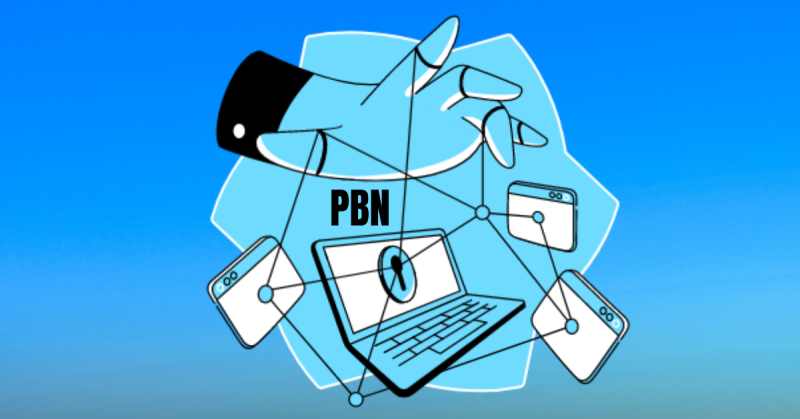While they can provide a quick boost in search rankings by creating a network of linked websites, they also come with significant risks. Search engines like Google actively discourage manipulative link-building tactics, and using a PBN improperly can lead to penalties or even deindexing. So, is a PBN a smart SEO strategy or a risky shortcut? In this article, we’ll break down what a PBN is, how it works, and whether it’s a viable option for improving your website’s SEO.
How Private Blog Networks (PBN) Work in SEO
Private Blog Networks (PBNs) have become a widely debated topic in the world of SEO. These networks, when used correctly, can provide a significant boost to a website’s search engine rankings. However, as with any SEO technique, there are both advantages and risks associated with using PBNs. In this guide, we will dive into how PBNs work, the mechanics of setting one up, their SEO benefits, Google’s stance on them, and how to minimize potential risks.
In the ever-evolving world of search engine optimization (SEO), strategies come and go, but one tactic that has persisted—despite controversy—is the use of private blog networks, commonly referred to as PBNs. For those unfamiliar with the term, you might wonder, what is a PBN? Simply put, a PBN is a collection of websites created with the primary purpose of generating backlinks to a target site, often called the “money site,” to improve its rankings on search engines like Google. These networks leverage the authority of individual sites within the PBN to pass link juice, a term used to describe the SEO value transferred through hyperlinks.
The concept of a PBN might sound straightforward, but its execution is anything but simple. It involves acquiring domains, setting up websites, and strategically linking them in a way that mimics natural link-building—while avoiding detection by search engines. For businesses or individuals looking to boost their online presence, the allure of PBN SEO lies in its potential to deliver fast, measurable results. However, it’s not without risks, as Google has made its disapproval of manipulative link-building tactics abundantly clear over the years.
In this article, we’ll dive deep into how to build PBN links, explore the mechanics behind them, weigh their benefits against SEO risks, and compare them to legitimate alternatives. Whether you’re considering buying PBN backlinks or simply curious about what is pbn links are, this guide will provide clarity on this polarizing SEO strategy.
The Mechanics of a PBN
Private Blog Networks (PBNs) work by leveraging a set of domains that are controlled by a single entity and used to create backlinks to a target website. This method involves using authoritative expired domains to build a network of websites that link back to your primary website. The goal is to improve the ranking of the target site by passing on link equity through these backlinks.

Acquiring Expired Domains
The first step in setting up a PBN is acquiring expired domains. These domains are ones that were previously registered but have lapsed, either due to the owner’s failure to renew them or because the website was abandoned. The key to a successful PBN lies in the authority and history of the expired domains. High-quality expired domains will have good domain authority, backlinks from other reputable websites, and no history of spammy activity.
To identify valuable expired domains, you need to research their history and assess their backlink profile. Tools like Ahrefs, SEMrush, or Majestic can help determine the strength of a domain by showing its link profile, referring domains, and other key metrics.
The foundation of any PBN lies in its domains. Rather than starting from scratch with new, untested domains, most PBN builders seek out expired or auctioned domains with existing authority. These are websites that once had strong backlink profiles, high domain authority (DA), and relevance in their niche but were abandoned by their original owners. The idea is to resurrect these domains and harness their residual SEO power.
Finding these domains requires research. Tools like Ahrefs, Moz, or specialized platforms for buying PBN domains can help identify candidates with clean histories—meaning no spam or penalties tied to them. For example, a domain that once hosted a reputable blog about fitness could be repurposed into a PBN site linking to a gym equipment store. The cost of buying PBN backlinks often starts here, as premium expired domains can range from $50 to thousands of dollars, depending on their metrics.
Setting Up a PBN: Hosting, CMS, and Content
Once you’ve acquired your expired domains, the next step is to set up the network. Proper PBN hosting is crucial to ensure that the network remains undetected by search engines. You need to use separate hosting providers for each domain in the network to prevent Google from identifying the domains as part of the same network.
Once domains are secured, the next step is setting up the PBN. This involves choosing PBN hosting, a critical decision that can make or break the network’s success. To avoid leaving a detectable footprint, savvy PBN operators use multiple hosting providers, IP addresses, and even different registrars. Shared hosting is often avoided in favor of dedicated or cloud-based solutions to keep sites separate and reduce the risk of Google connecting the dots.
The content management system (CMS) is typically WordPress due to its flexibility and ease of use, though other platforms can work too. After setup, the sites need content. This isn’t about slapping up low-quality, spun articles—modern PBNs require well-written, relevant posts that align with the domain’s original niche. For instance, if you buy PBN links for a tech site, the PBN sites might feature articles on gadgets or software reviews, subtly embedding PBN links to your target page.
Choosing the right Content Management System (CMS) is also essential for PBN setup. WordPress is the most popular CMS for building PBN websites due to its ease of use and flexibility. Once your websites are set up, you need to populate them with high-quality, relevant content. It’s important to make the websites look as natural as possible to avoid detection by Google’s algorithms.
Linking Strategies in a PBN
The primary purpose of a PBN is to create pbn backlinks for sale or links that point to a target website. When using PBN links, it’s essential to link strategically. This means linking to relevant pages of your website, rather than just the homepage. Using natural anchor text is key in avoiding penalties, and over-optimizing anchor text should be avoided.
One important aspect of linking strategies is the importance of making the links appear natural. Search engines look for patterns in backlinks, and if too many links come from the same source or are too similar in nature, they can trigger a red flag.
The real magic of a PBN happens in its linking strategy. What are PBN links? They’re the hyperlinks placed within the content of PBN sites that point to the money site. The goal is to make these links appear natural, as if they were earned organically. This might involve using varied anchor text—such as branded terms, generic phrases like “click here,” or exact-match keywords—and spacing out the links across multiple posts.
A common question is how to build PBN links effectively. Some operators use a tiered approach, where lower-tier PBN sites link to higher-tier ones, which then link to the money site. Others keep it simple with direct links. Regardless, over-optimization is a pitfall to avoid—too many exact-match anchors or links from irrelevant sites can raise red flags with Google’s algorithms.
The SEO Benefits of PBNs
PBNs can significantly boost rankings in search engines if done properly. The main advantage of using a PBN is its ability to provide high-quality backlinks to your website, which is one of the most important ranking factors for Google. These backlinks pass on link equity, which can improve the authority of your website and increase its chances of ranking higher for target keywords.

How PBNs Can Boost Rankings
PBN SEO works because of the strong link profiles that expired domains typically have. When these domains are used to link back to your website, they pass valuable authority. With this link juice, your website can rank for competitive keywords more easily. Additionally, PBNs can help diversify your backlink profile, which is crucial for a natural-looking SEO strategy. By spreading your backlinks across various domains in your network, you can make it harder for search engines to detect any manipulation.
The primary benefit of private blog networks is their ability to manipulate search engine rankings. By controlling a network of authoritative sites, you can funnel link equity directly to your money site, boosting its domain authority and pushing it up the search results. For competitive keywords where natural link-building takes months or years, PBN links can accelerate the process.
Imagine you’re running an e-commerce store selling outdoor gear. Ranking for “best hiking boots” might be tough with organic methods alone. By strategically placing PBN backlinks for sale on relevant sites within your network, you could see your page climb the rankings faster than competitors relying solely on outreach. This speed and control are why some SEOs buy PBN services despite the risks.
Google’s Stance on PBNs and Algorithm Updates
Google has made it clear that using PBNs is against its guidelines. The search engine giant actively seeks to penalize websites that engage in manipulative link-building practices. SEO risks are associated with PBNs because of this. Google’s algorithms are constantly evolving to detect unnatural link-building patterns, including those created through PBNs. Websites caught using PBNs may face penalties, ranging from a drop in rankings to a complete removal from the search index.
However, while Google frowns upon the use of PBNs, they remain a popular tactic for many webmasters due to the significant short-term SEO gains they can provide. It’s essential to be aware of the risks and weigh them against the potential rewards.
While PBNs can deliver results, they exist in a gray area of SEO. Google explicitly forbids manipulative link schemes, and private blog networks fall squarely into this category. According to Google’s Webmaster Guidelines, any attempt to artificially inflate rankings through paid or controlled links violates their rules.
Over the years, algorithm updates like Penguin have targeted unnatural link profiles. Sites caught using PBNs risk penalties ranging from rank drops to full de-indexing. The PBN meaning in Google’s eyes is clear: it’s a black-hat tactic designed to game the system. Detection methods have improved, with AI now analyzing link patterns, hosting footprints, and content quality to identify PBNs. This cat-and-mouse game makes SEO risks a constant concern for PBN users.
PBNs vs. White-Hat SEO Strategies
When it comes to SEO, there are two primary approaches: PBN SEO (Black-Hat SEO) and White-Hat SEO. The key difference between the two is that White-Hat SEO focuses on strategies that align with Google’s guidelines, while Black-Hat techniques like PBNs seek to manipulate search engine algorithms to gain an advantage.
Comparing PBNs to Natural Link-Building
What is PBN in SEO is a question that often arises, and while PBNs can provide quick results, they are not as sustainable as natural link-building methods. Natural link-building involves earning backlinks through content marketing, outreach, and creating high-quality, shareable content. Over time, this approach leads to organic growth and long-term SEO success, whereas PBNs may give immediate results but can lead to penalties if detected by Google.
Natural link-building involves earning backlinks through high-quality content, outreach, and relationship-building. For example, publishing a groundbreaking study on your site might attract links from bloggers and journalists organically. In contrast, PBN links are manufactured, giving you control over quantity and placement but lacking authenticity.
White-hat SEO takes longer and requires more effort, but it’s sustainable. A PBN might give you a quick rankings boost, only to crumble under a Google penalty. Natural links, while harder to earn, build a foundation that withstands algorithm shifts.
How White-Hat SEO Can Achieve Similar Results
While using a PBN might provide an instant boost to rankings, White-Hat SEO strategies can achieve similar results over time without the risk of penalties. By focusing on creating valuable content, earning natural backlinks, and engaging with your audience, you can achieve steady growth and maintain long-term rankings.
Can white-hat methods rival PBN SEO? Absolutely. Tactics like guest posting on reputable sites, creating linkable assets (e.g., infographics or tools), and optimizing on-page SEO can elevate rankings without the SEO risks of PBNs. For instance, instead of buy pbn backlinks, you could collaborate with industry influencers to earn mentions. The trade-off is time—white-hat success is a marathon, not a sprint.

How to Minimize Risks If Using a PBN
If you decide to go ahead with using a private blog network, it’s important to take steps to minimize the risks involved.
Blending PBNs with Other SEO Methods
One way to reduce the risks associated with PBNs is by blending them with other SEO methods. For example, combine PBN link-building with White-Hat SEO techniques such as guest posting, content marketing, and influencer outreach. This will make your overall SEO strategy appear more natural and reduce the chances of detection. Additionally, make sure the content on your PBN sites is high-quality and relevant to your target audience.
Should You Use a PBN for SEO?
The decision to use a PBN for SEO ultimately depends on your goals, resources, and risk tolerance. PBNs can offer quick results, but they come with significant risks.
When a PBN Might Be a Viable Option
Using a PBN might be a viable option if you are looking for quick results in competitive niches and are prepared to manage the network effectively. If you have the resources to acquire high-quality expired domains and maintain your PBNs across different hosting providers, then it can be an effective strategy.
Who Should Avoid Using PBNs?
If you are risk-averse or looking for long-term, sustainable growth, it’s best to avoid using PBNs. White-Hat SEO techniques offer a safer and more sustainable approach to SEO that aligns with Google’s guidelines.
Final Thoughts on PBNs and SEO
Private Blog Networks can be a powerful tool for boosting your website’s rankings when used strategically. However, SEO risks are inherent in using PBNs, and Google’s algorithm updates are designed to detect and penalize manipulative tactics. If you decide to use a PBN, it’s essential to take steps to minimize risks, blend the approach with other SEO techniques, and ensure that the network appears natural to search engines.
Ultimately, while PBNs can provide quick wins in terms of SEO, they are not a long-term strategy. For sustainable and penalty-free SEO growth, it’s recommended to focus on White-Hat SEO techniques that align with Google’s guidelines. If you’re unsure whether to use a PBN, consider seeking advice from an SEO professional to ensure you make the best decision for your website’s long-term success.
Together We Rise: A Campaign for Everyone